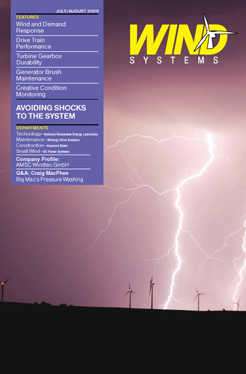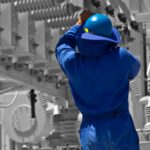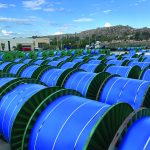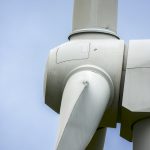When the geotechnical exploration at a planned wind turbine tower location reveals that the subsurface conditions are weak and compressible, a deep foundation system consisting of a mono-pole or drilled/driven piles is often recommended by the geotechnical engineer. However, often the poor soils can be strengthened and stiffened economically to enable the tower to be constructed on a shallow mat foundation. One ground improvement technique consists of constructing a regular pattern of dense aggregate piers within the weak soils. This process is referred to by several names such as aggregate piers, stone columns, or vibro-replacement. Aggregate piers are typically constructed using one of two tools: a down-hole vibrator, or a tamper. Both methods are available as a design-build service by specialty contractors.
The vibrator is a specially-built tool consisting of a ±18 inch diameter closed end steel casing with an internal electric or hydraulic motor spinning an eccentric weight. The rotating eccentric weight causes the vibrator to oscillate horizontally. The vibrator can be suspended from a crane, excavator, or attached to a fixed-mast drill rig. The vibrator penetrates the ground by means of its weight or drill rig down-thrust and is assisted by the vibratory energy and, occasionally, water jetting. Aggregate is placed in lifts, each of which is compacted by repeated penetration of the vibrator. This action both densifies the aggregate and laterally displaces the aggregate to compress the surrounding soils. The vibrational energy will also densify surrounding granular strata, which enables liquefaction mitigation that is fully verifiable with post-construction geotechnical field testing.
The tamper is a proprietary tool consisting of a beveled tamper powered by a top-drive hydraulic hammer. The aggregate pier is constructed by vertically compacting one- to two-foot lifts of aggregate with the tamper system. Aggregate piers constructed in cohesive soils with either technique perform similarly. However, because the tamper applies vertical energy to the aggregate rather than horizontal energy, the tamper method does not densify surrounding granular strata. This lack of soil densification limits the ability to provide fully-verifiable liquefaction mitigation with a tamper. Aggregate piers do not simply transfer the load to a deeper stratum like a traditional deep foundation, but instead work together with the surrounding soil to produce an improved composite beneath the foundation.
The resulting soil/aggregate composite is much stronger and stiffer than the original soils, providing increased bearing capacity and reduced settlement. If uplift resistance is required for the foundation, anchor bars can be incorporated during pier construction and tied into the mat foundation. If additional uplift resistance beyond that provided by the piers is required, soil or rock anchors can be installed.
A quality control program is essential to assure the successful performance of an aggregate pier foundation. Field-scale testing should be performed at the beginning of the program to verify construction quality and design parameters. Consistent pier quality is ensured by monitoring the construction procedure and aggregate quantity. If liquefaction mitigation is required and granular soils are present, post-construction geotechnical penetration testing between piers is required to verify that the required densification is achieved.
When properly designed and constructed, a mat foundation bearing on aggregate piers is an efficient and economical alternative to traditional deep foundation systems for many wind turbine sites with difficult soil conditions.




































